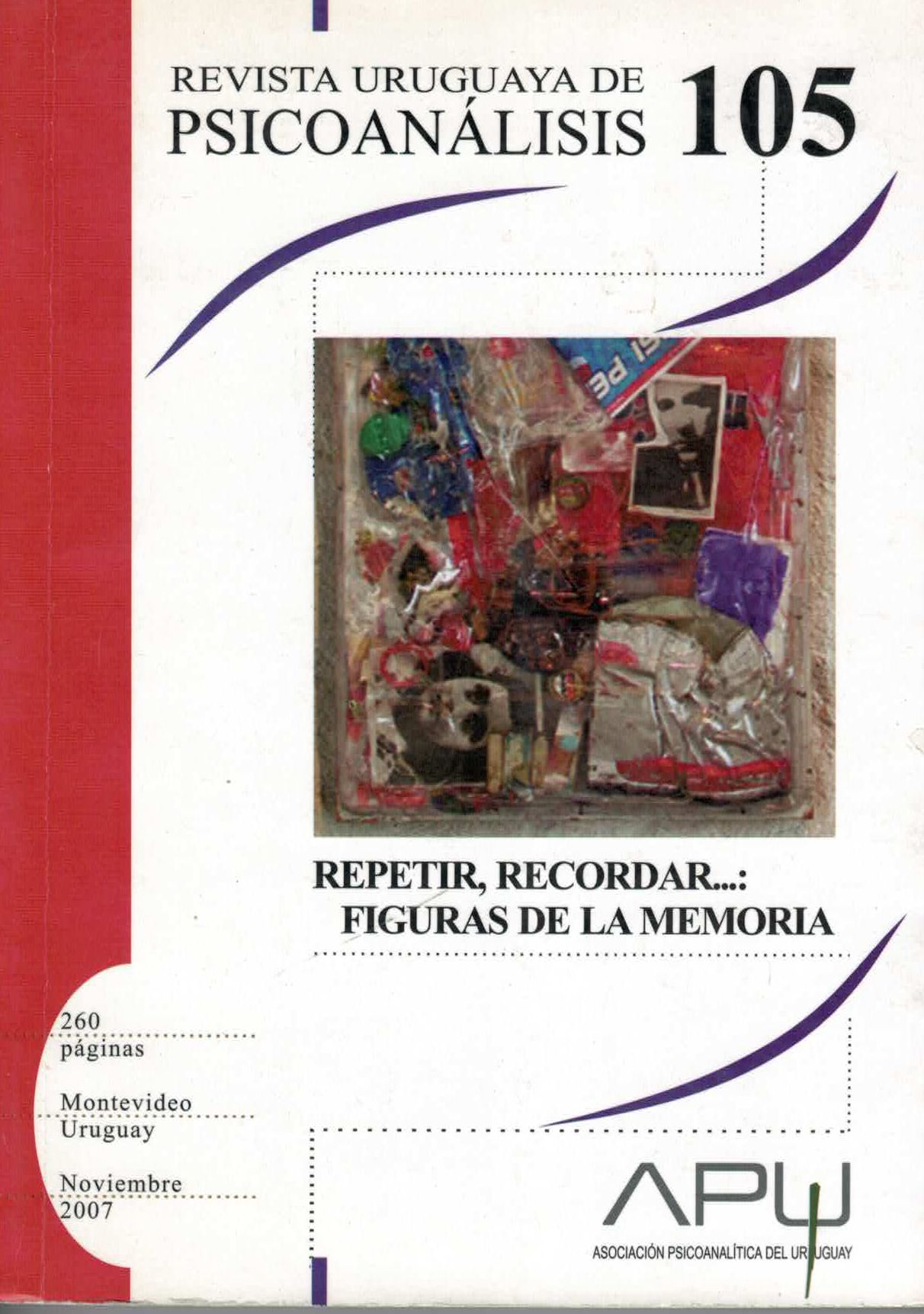Acerca de los distintos procesos de elaboración
Palabras clave:
elaboración, simbolización, investigación científica, apego, material clínicoResumen
A partir del análisis de un niño de ocho años y medio con quien tuve la oportunidad de tener algunas entrevistas veintitrés
años después, trataré de pensar el tema de la elaboración en el psicoanálisis de niños.
La confrontación entre las teorías, la clínica y mi experiencia de investigación microanalítica en el vínculo madre-bebé me ha
llevado a formular nuevos interrogantes, y su respuesta me ha conducido a percibir la elaboración bajo una nueva y más compleja
perspectiva. (Altmann, M., 2000, 2001, 2002) Más que de elaboración, hablaré de diferentes procesos de
elaboración que tienen que ver con distintos sistemas: apego, narcisismo, sensualidad y sexualidad; cada uno con sus propios
deseos, motivaciones y objetos que los satisfacen (Bleichmar, H. 2004).
Descargas
Referencias
ACEVEDO DE MENDILAHRZU, S. (1977) El carácter obsesivo y la estructura perversa. RUP 56. pp. 31-50
ALTMANN, M. (1987a) Sobre la experiencia del dolor psíquico y algunas de sus transformaciones. Inédito.
ALTMANN, M. (1987b) Aspecto de la parte psicótica de la personalidad en el análisis de un niño. RUP 66, pp.57-68.
ALTMANN, M. (2002) Jeu et régulation affective, Revue Spirale N° 24:Jeu bébé jeu, December, pp. 138-149.
ALTMANN, M. (2003) Agresividad y transferencia negativa en el contexto de la teoría del apego y la función reflexiva, RUP N° 97, pp. 29-49.
ALTMANN, M. & GRIL, S. (2001) Relationship Between the Verbal Exchange of Mother and Analyst and the Non-Verbal Interaction Between
Mother and Baby, in Proceedings of the 1st. Latin-American IPA Research Conference, Santiago de Chile, 1999. Research in Psychoanalysis and
Psychotherapy, pp. 119-134.
(2000) Relaciones entre duelo y apego en el vínculo madrebebé. Desde la clínica a la Investigación empírica, en Los duelos y sus
destinos. Depresiones Hoy, Proceedings of the First Psychoanalytic Congress of APU, Volumen II, pp. 219-223.
BALINT, M. (1934) The final goal of psychoanalytic treatment In Primary Love and Psychoanalytic Technique. London: Hogarth Press, 1952 pp.
-189.
BALINT, M. (1937) Early developmental states of the ego In Primary Love and Psychoanalytic Technique London: Hogarth Press, 1952 pp.
-90.
BARANGER M, BARANGER W, MOM J. (1983). Process and Nonprocess in analytic work. Int J Psychoanal 64: 1-15.
BEDO T. (1988) Insight, Perelaboración e interpretación. RUP 68, pp.59- 87.
BEEBE B., LACHMANN F.M. (1994). Representation and internalization in infancy: Three principles of salience. Psychoanalytic Psychology, 11,
-165.
(1998). Co-constructing inner and relational processes. Self and mutual regulation in infant research and adult treatment.
Psychoanalytic Psychology, 15, 1-37.
(2002). Infant Research and Adult Treatment: Coconstructing Interactions. Hillsdale, N.J: The Analytic Press.
BERENSTEIN, I. & PUGET, J. (1997) Lo vincular. Clínica y técnica psicoanalítica. Buenos Aires: Paidós.
BERNARDI, R. (1987) Vulnerabilidad, desamparo psicosocial y desvalimiento psíquico en la edad adulta, RUP 67, pp. 23-44.
BIANCHEDI E. SOR, D. Y GRINBERG, L. (1979) Introducción a las ideas de Bion, Nueva Visión.
BION, W. (1962) Aprendiendo de la experiencia. Ed. Paidós. Buenos Aires,1966.
(1970) Atención e interpretación. Buenos Aires: Paidós.
(1972) Desarrollos del pensamiento esquizofrénico. Volviendo a pensar. Ed. Hormé.
BLATT, S. J. AND BLASS, R. B. (1990). Attachment and Separateness— A Dialectic Model of the Products and Processes of Development
Throughout the Life Cycle. Psychoanal. Study Child, 45:107-127.
BLEICHMAR, H. (2004) Hacer consciente lo inconsciente para modificar los procesamientos inconscientes: algunos mecanismos del cambio
terapéutico. Publicado en el International Journal of Psychoanalysis, 85
(2004), 1379-1400. Revista Aperturas psicoanalíticas www.aperturas.org Nº22, 2006.
BLOS, P. (1979) The Adolescent Passage New York: Int. Univ. Press.
BOWLBY, J. (1969-73) Attachment and Loss 2 vols. New York: Basic Books.
(1988) Developmental psychology comes of age Amer. J. Psychiat. 145:1-10.
BRAUN, S., CUTINELLA, O. Y ALTMANN, M. (1986) Algunas reflexiones sobre el juego y la acción en relación a los procesos de
simbolización desde una perspectiva kleiniana, Biblioteca Uruguaya de Psicoanálisis, Vol. 1, APU, Montevideo, Uruguay, pp.103-116.
BUSCH, F. (1994). Some ambiguities in the method of free association and their implications for technique. J Am Psychoanal Assoc 42: 363-
CASAS DE PEREDA, M. (1999) En el camino de la simbolización. Buenos Aires, Paidós.
CHOMSKY N. (1984). Modular Approaches to the Study of the Mind.San Diego: San Diego State University Press.
CLYMAN, R. (1991). The procedural organization of emotions: A contribution from cognitive science to the psychoanalytic theory of
therapeutic action. J Am Psychoanal Assoc 39 (S), 349-382.
COOPER, S. (1997). Modes of influence in psychoanalysis. J AmPsychoanal Assoc 45: 217-229.
DAVIDSON, R.J.; SHERER, K.R.; GOLDSMITH, H.H. (Ed) (2003).
Handbook of Affective Sciences. New York: Oxford University Press.
DAVIS, J.T. (2001). Revising psychoanalytic interpretations of the past. An examination of declarative and non-declarative memory processes.
Int J Psychoanal 82: 449-462.
DE LEÓN DE BERNARDI, B. (2003). Discusión del trabajo “La interpretación y el saber en psicoanálisis. Revista de Psicoanálisis 60:
-23.
DIO BLEICHMAR, E. (2000) Lo intrapsíquico y lo intersubjetivo: metodología de la psicoterapia de la relación padres- hijo/as desde el
enfoque modular-transformacional. Aperturas Psicoanalíticas Nº6.
(2005) Manual de psicoterapia de la relación padres e hijos. Buenos Aires, Paidós
EGLÉ, M. (1994). Formulation of interpretation—From truth to experience. Int J Psychoanal 75: 1093-1105.
ETCHEGOYEN, H. (1986) Los fundamentos de la técnica psicoanalítica.Buenos Aires: Amorrortu Editores (1993).
EMDE, R. N. (1981) Changing models of infancy and the nature of early development, J. Am. Psychoanal. Assoc. 29:179-220.
EMDE, R. N. (1983) The Prerepresentational Self and its Affective Core,Psychoanalytic Study of the Child, 38:165-192.
EMDE, R.N. (1988) Development terminable and interminable. Int. J.Psychoanal. 69:23-42.
FAIRBAIRN, W.R.D. (1952) Psychoanalytic Studies of the Personality London: Tavistock.
(1963) Synopsis of an object relations theory of the personality Int. J. Psychoanal. 44:224-225.
FONAGY, P. (1999). Memory and therapeutic action. Int J Psychoanal 80: 215-224.
(2001) Attachment Theory and Psychoanalysis, Ed. OtherPress New York.
FONAGY, P.; GERGELY G.; JURIST E.; TARGET, M. (2002). Affect Regulation, Mentalization and the Development of the Self. New York:
Other Press.
FONAGY, P. & TARGET, M. (1998) Mentalization and the changing aims of child psychoanalysis. Psychoanalytic Dialogues, nº8, p.87-114.
FREUD, S. (1914). Recordar, repetir, reelaborar. Obras Completas XII Buenos Aires: Amorrortu.
(1919). Nuevos caminos de la terapia psicoanalítica. Obras Completas XVII. Buenos Aires: Amorrortu.
Freud, A. (1946). The ego and the mechanisms of defense. New York, N.Y.: International Universities Press.
(1965) Assessment of pathology in childhood Writings 5:26-59.
(1974) A psychoanalytic view of developmental psychopathology Writings
GUNTRIP, H. (1969) Schizoid Phenomena, Object Relations and the Self New York: Int. Univ. Press.
(1971) Psychoanalytic Theory, Therapy and the Self London: H. Karnac, 1977.
KENNEDY, H. (1979). The Role Of Insight In Child Analysis: A Developmental Viewpoint. Journal of the American Psychoanalytic
Association, 27(S):9-28.
KLEIN, G. S. (1976) Psychoanalytic Theory New York: Int. Univ. Press.
KLEIN, M. (1926) Principios psicoanalíticos del análisis infantil- enContribuciones al psicoanálisis, Ed. Hormé.1964.
. (1987) Obras completas. Psicoanálisis de niños. Vol. IIBuenos Aires, Paidós.
KOHUT, H. (1971) Análisis del self. Buenos Aires, Amorrortu.
(1977) La restauración del self. Buenos Aires, Amorrortu.
LACAN, J. (1936) «Le stade du miroir» Publicación: International Jour.of Psychoanalysis
Nº 1, 1937, pp. 78 y ss.
LYONS-RUTH, K. (1998) Implicit relational knowing: Its role indevelopment and psychoanalytic treatment. Infant Mental health Journal,
, 282-291.
MAHLER, M. S. (1963) Thoughts about development and individuation. Psychoanal. Study Child 18:307-324.
(1967) On human symbiosis and the vicissitudes of individuation In The Selected Papers of Margaret S. Mahler 2:77-97
New York: Jason Aronson, 1979.
(1972) On the first three subphases of the separationindividuation process In The Selected Papers of Margaret S. Mahler2:119-130 New York: Jason Aronson, 1979.
(1974) Symbiosis and individuation In The Selected Papers of Margaret S. Mahler 2:149-165 New York: Jason Aronson, 1979.
MARTY P. (1980) L’ordre psychosomatique. Les mouvements individuels de vie et de mort. Essai d’économie psychosomatique, Tome 2, Paris:
Payot.
OGDEN, T. (1989) The primitive edge of experience. Northvale, N.J. Aronson.
RIFFLET-LEMAIRE, ANIKA (1970) Lacan. Buenos Aires, Editorial
Sudamericana
SELIGMAN. S. (1999). Integrating Kleinian Theory and Intersubjective
Infant Research. Observing Projective Identification. Psychoanalytic
Dialogues. A Journal of Relational Perspectives, vol. 9, No. 2, pp. 129-159. Copyright 1999 de Analytic Press, Inc. Traducido y publicado en
www.aperturas.org con autorización de The Analytic Press, Inc.Traducción de H. Bleichmar.
SETTLAGE, C. F. (1980) The psychoanalytic theory and understanding of psychic development during the second and third years of life In The
Course of Life ed. S. I. Greenspan & G. H. Pollock. Washington, D.C.: NIMH, pp. 523-539.
SILVERMAN, D.K. (1988) “Sexuality and attachment: A passionate relationship or a marriage of convenience?” fue publicado originariamente
en The Psychoanalytic Quarterly, vol. LXX, no. 2, págs. 325-358.
Copyright The Psychoanalytic Quarterly Traducido y publicado con el permiso de The Psychoanalytic Quarterly.
SPITZ, R. A. (1965) The First Year of Life New York: Int. Univ. Press en www.aperturas.org.
STEELE, H., STEELE, M & FONAGY P. (1991) Associations among Attachment Classifications of Mothers, Fathers, and Their Infants En
Child Development, Vol. 67, No. 2 (Apr., 1996), pp. 541-555.
STERN, D. N. (1977) The First Relationship Cambridge, Mass.: Harvard Univ. Press.
(1983) The early development of schemas of self, of other and of various experiences of “self with other.” In Reflections on Self
Psychology ed. S. Lichtenberg & S. Kaplan. Hillsdale, N.J.: Analytic Press, pp. 49-84.
(1985) The Interpersonal World of the Infant New York:Basic Books.
(1988) Affect in the context of the infants’ experience Int. J.Psychoanal. 69:233-238[à].
(1995) La constelación maternal. Barcelona: Paidós.
STERN, D.; SANDER, L.; NAHUM, J.; HARRISON, A.;BRUSCHWEILER-STERN, N. & TRONICK, E. (1998) Noninterpretative
mechanisms in psychoanalytic therapy. InternationalJournal of Psycho-Analysis, 79, 903-921.
TRONICK, E. (1989) Emotions and emotional communication in infants. American Psychologist, 44, 112-119.
VOLINSKI DE HOFFNUNG, P.; MEDICI DE STEINER, C.; SAPRIZA, S.; ALTMANN, M.; CUTINELLA, O.; IHLENFELD DE ARIM, S.;
LÓPEZ DE CAYAFFA, C. y VALLESPIR, N. (1986) En El juego en psicoanálisis de niños, Biblioteca Uruguaya de Psicoanálisis, Vol. 1,
APU, Montevideo, Uruguay, pp.129-194.
WATSON & GERGELEY. (1996). The social biofeedback theory of affect mirroring. En: Fonagy, P, et al. Editors. Affect Regulation, Mentalization
and Development of the Self. Ed. Other Press, New York, 2000.
WINNICOTT, D. W. (1958) The capacity to be alone In The Maturational Processes and the Facilitating Environment London: Hogarth Press,
pp. 29-36.
(1971) Playing and Reality London: Tavistock.
(1979) El Proceso de Maduración en el Niño. Editorial Laia, Barcelona, 2da. Ed.










 This work is licensed under a
This work is licensed under a 